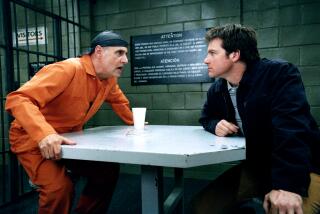Getting a Grip on ‘Ransom’s’ Little Gaffe
- Share via
It was a “producer’s nightmare,” Brian Grazer admits: a microphone hovering over Mel Gibson and Rene Russo in a frame of “Ransom”--Ron Howard’s suspenseful thriller about a man who takes matters into his own hands after his son is kidnapped.
And to make matters worse, the gaffe was first detected at a well-attended media screening at Westwood’s Avco theater Nov. 4, where it provoked snickers from some in the crowd.
“When Ron and I heard about it, we wanted to kill ourselves,” Grazer said. “We’d looked at the film for months and no one had picked that up. You could say it’s the fault of the director or the cinematographer or the editor, for that matter--anyone it got by. But it wouldn’t have mattered had the movie not been badly framed by the projectionist.”
The microphone remains on the 2,600-plus prints of “Ransom” shipped nationwide but shouldn’t be visible if the film is properly projected, Grazer said.
Slip-ups like that are common, according to acclaimed cinematographer Caleb Deschanel (“The Black Stallion,” “Fly Away Home”). Movies are shot with a bigger negative--more on the top and bottom--than intended for projection so they can be adapted to an essentially “square” format at the time of a video sale. Since the print always shows more than you want, he pointed out, the potential for error is there.
“I periodically go to the theaters to check out films I’ve done,” Deschanel said. “Quite often I find the top of people’s heads cut off because the frame has been pushed up or, if the frame is pushed down, microphones dangling into a shot. A friend called my mother up after seeing one during a screening of ‘Fly Away Home.’ That’s a result of the age-old battle between sound and the visual image. The poor sound man must get as close as possible or the voices will sound like they’re in a concert hall.”
Deschanel recalled a grip truck in a scene in a film set in the 17th century, which the filmmakers erased digitally. “You can do that on occasion,” he said, “but microphones are always in the full frame. If you used the process every time you fear a film will misproject, movies would cost twice as much.”
Filmmakers turn somersaults to ensure everything is right, Grazer said. But one episode tempered his perfectionism a bit. Warner Bros. Chairman Robert Daly and then president (and current co-chair) Terry Semel joined a handful of press attending a screening of 1982’s “Night Shift”--the first film on which he and Howard worked together. Midway through, Grazer realized that one of the reels was missing.
“We worry about the sound mix, framing, people watching our movies on a small screen . . . and then 22 minutes is cut from your film and nobody notices,” Grazer recalled. “A big screenwriter friend of mine told me the movie played better than ever. People clapped at the end. . . . No one had any idea. I learned that if the movie works, it doesn’t matter if goofy things happen. But if the story is bad or the characters not engaging, nothing will help.”
More to Read
The biggest entertainment stories
Get our big stories about Hollywood, film, television, music, arts, culture and more right in your inbox as soon as they publish.
You may occasionally receive promotional content from the Los Angeles Times.










